The world’s second largest country isn’t likely to be short on wonders. But what’s truly remarkable about Canada is how great it is at sharing them. Even in the remote and chilly Yukon, you can take a family holiday to see the Aurora Borealis. The wildly beautiful Rockies couldn’t be more hospitable to skiers, climbers or even train travellers. And if your heart’s set on cities, they’re pretty wonderful too and so many to choose from. In fact, that’s the only quibble about Canada: too much choice. So if there’s an amazing adventure missing in the following ten, you know where to lay the blame.
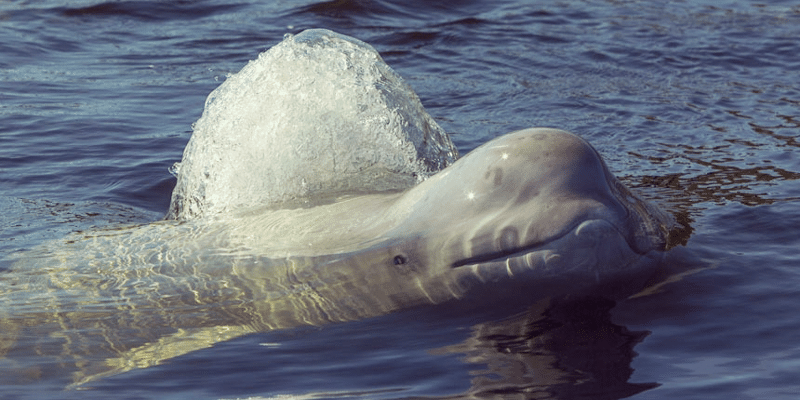
Photo credit: Andrei Kamenev
1/10 Kayaking with Beluga Whales, Churchill, Manitoba
They’re called, ‘the white ghosts of the north’, and no other cetacean is more distinctive or wonderfully strange than the blanched Beluga Whale.
Every year, from mid-July to mid-August thousands of these mesmerising creatures gather at the Churchill River Estuary on Hudson Bay in the far northern reaches of Manitoba. They’re ridiculously sociable with each other and insatiably curious about human interlopers sailing or snorkelling in their territory. Get close enough to one and don’t be surprised if it turns and looks at you: Beluga are the only whale with flexible necks.
Obviously they aren’t as huge as Killer Whales (almost nothing is) but an adult male weighs in at about 500 kilos and tops lengths of four metres. So for all the milky, smiley face cuteness, they’re pretty imposing to be around.
One of the best ways to meet Beluga with kids is to take a kayaking tour from Churchill town. No paddling experience is needed and double kayaks are great for younger children. All tours are accompanied by safety Zodiac – the more sailors, the more dinghies. And calm weather’s a pre-requisite for sailing so no Captain Ahab drama on this astonishing adventure.
Where: Churchill, Hudson Bay, Manitoba
When: daily in July and August, weather permitting
Who: Sea North Tours, Churchill, Manitoba
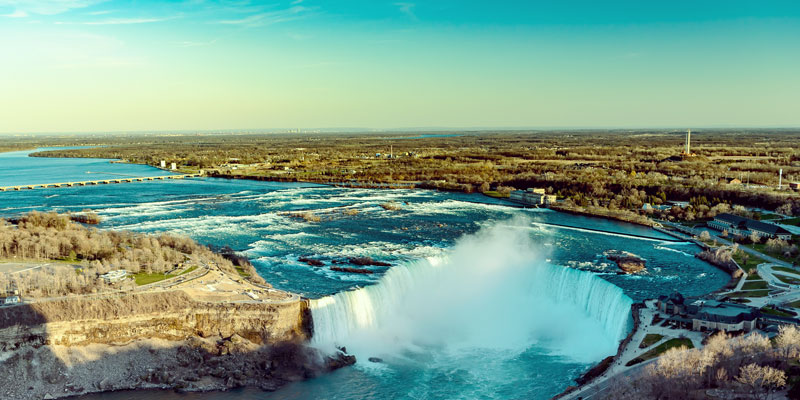
2/10 Niagara Falls, Ontario
For sheer magnetism, Niagara Falls are hard to beat. Most visitors don’t think about crossing them on a tightrope as Nick Wallenda did, successfully, in 2012. Even fewer would dream of plunging down the 52 metre drop in a kayak without a helmet or lifejacket – that stunt didn’t go so well. But there’s almost nobody on earth within travelling distance of the world’s widest waterfalls who doesn’t want to see what all the fuss is about.
The enormous (and most famous) Horseshoe Falls are in Canada – the US owns the considerably smaller Bridal Veil Falls – so the most spectacular cruises are Canadian too. You can sail in the evening for as much romance as the roar of 168,000m³ of falling water per minute allows. The Illumination and Firework sails are pretty stunning too. But they’re all ‘light mist’ and it’s Niagara Falls, so opting to get a bit damp kind of misses the point.
To the heart of the falls on a ‘full mist’ voyage is the only way to go. Everyone gets a mist cape and despite the drenching and astounding noise, the custom-built Niagara catamarans are a surprisingly smooth sailing experience – even for young kids. The round trip takes just over 20 minutes but they’re fairly adrenalin-rich, so be prepared.
Where: Niagara Falls, Ontario
When: cruises every 15 minutes daily from 1 April to 30 November
Who: Hornblower Niagara Cruises
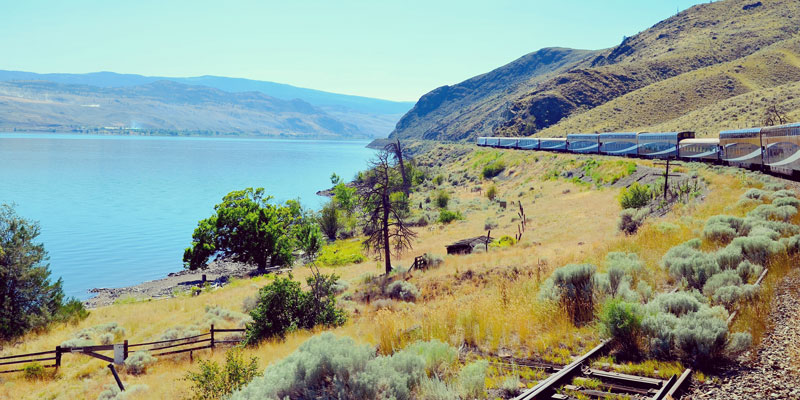
3/10 Rocky Mountaineer ‘First Passage to the West’ rail journey
Every great country has great rail journeys, but Canada also has the Rockies and the legendary Rocky Mountaineer. Which pretty much means it wins hands down on majestic grandeur, history and ‘just sit back and enjoy the ride’ good old fashioned opulence.
From the 360˚ viewing carriage to the plump seats, charming crew and gracious pace, the Rocky Mountaineer is one of the world’s finest trains. Only fitting then, that the First Passage to the West route between Vancouver and Banff is number seven in the World’s Top 25 Rail Journeys. Once called the ‘Kicking Horse’, this two day voyage travels along Canada’s original trans-continental line, first opened in 1885. The standard of comfort’s raised quite a bit since then, but the scenery’s barely changed at all.
Awe-struck wonder is a default position. One minute you’re sweeping past pristine, glacial lakes and the next, towering peaks hug the tracks and mighty canyons break the horizon. Cutest ‘time stood still’ stations are next to normal on-route. Ospreys and eagles swoop overhead and kids have been known to spot black bears or even grizzlies – grown ups are usually too relaxed for that type of keen-eyed observation. But nothing too much is missed: the entertaining and well informed Rocky Mountaineer conductors make sure of that.
Where: Vancouver – Kamloops – Lake Louise – Banff
When: from April to October, two day journey with overnight hotel stay
Who: Rocky Mountaineer
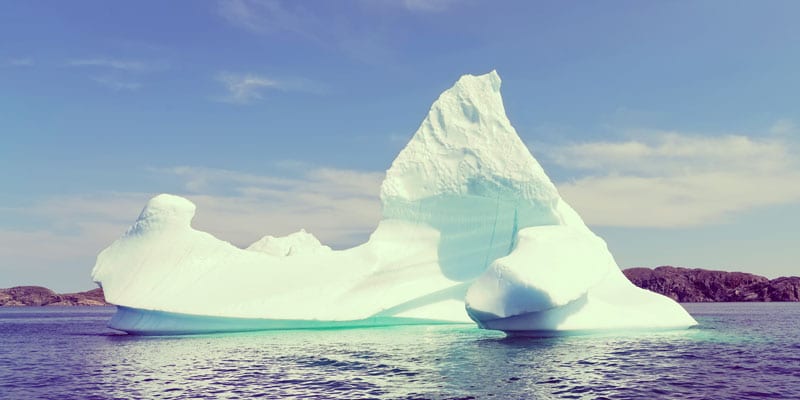
4/10 Iceberg Quest, St. John’s, Newfoundland
If you want to see icebergs up close, head to Newfoundland. This is as far east as you can go in Canada and what they don’t know about immense free floating chunks of glacier round these parts isn’t worth knowing. It was just 400km from Newfoundland that the ‘unsinkable’ Titanic met her frozen nemesis.
Today’s sailors are a bit more circumspect about tempting fate, especially as the monolithic ice mountains above the surface are nothing compared to what lies beneath: up to 90% of an iceberg’s total bulk is entirely submerged. So late spring cruises into the ice kingdom off the Newfoundland coast are stunning and safe.
But icebergs aren’t the only spectacle. Between mid-June and late August every year the world’s largest population of whales migrate through these chilly waters. Breaching Humpbacks are a common sight, along with slightly smaller Minke, outrigger porpoises, Finback whales and, most prized of all, the gargantuan Orca.
Timing a voyage to fit in icebergs and whales takes a bit of planning, but it can be done. Pull it off and, as far as the kids are concerned, you can probably sit back and rest on those parental laurels indefinitely.
Where: Twillingate or St. John’s, Newfoundland
When: daily from 1 May (weather permitting)
Who: Iceberg Quest Ocean Tours

5/10 Northern Lights, Whitehorse, Yukon
Bucket, wish or to-do? Whatever you want to call the list everyone has to some extent, it’s a safe bet the Aurora Borealis is on there somewhere. The good folks of Edinburgh claim you can see the phenomena in the city centre every now and again: no surprise, photographic evidence of that’s hard to find. Bleaker bits of Scandinavia are a much better bet. But if you want Northern Light guarantees, you want Yukon.
Canada’s north west territory is ancestral home to 14 of the country’s First Nations, keeper of ancient legends and land of the Klondike Gold Rush. Bold adventuring’s second nature here and wilderness is basically the backyard.
Fear not, seeing the Northern Lights won’t demand extremes of endurance. Cosy cabins, deliciously deep and mysterious forests, crisp winter days and tough Arctic gear for viewing expeditions are more the kind of expectation you should have. Kids are suitably cossetted without being mollycoddled and the fun goes well beyond staring at a night sky.
Yukon’s lightshow switches on as early as late August, peaks from November to January and still looks fairly astonishing right up until early April.
Where: Whitehorse, Yukon
When: from late August to early April – one night to five day tours.
Who: Northern Tales
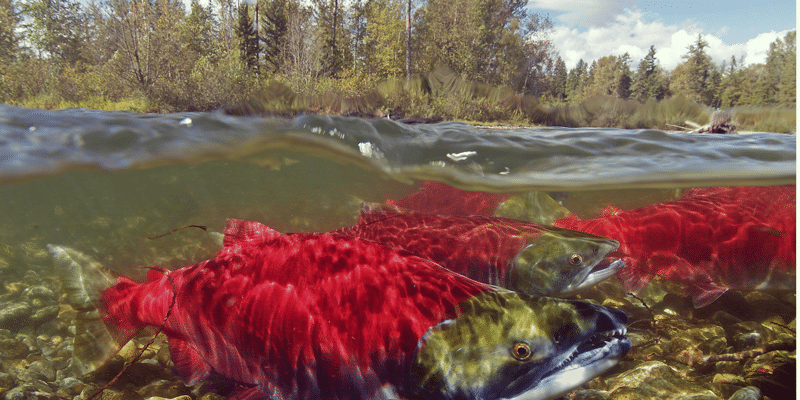
6/10 Salmon Snorkelling, Vancouver Island, British Columbia
The lifecycle of Pacific Salmon is one of the nature’s greatest mysteries and another of those, ‘but why?’, questions kids love to ask. Parents on Vancouver Island have it easy: they just pack their inquisitive offspring into a wetsuit, pop a mask over their heads and point them in the direction of the Campbell River.
Known as the Salmon Capital of the World, this river’s the freshwater start and finish to life for these fascinating fish. It takes every one of thousands of salmon hatched here upwards of seven years to return. In that time they’ll have travelled downstream to Puget Sound and round the Arctic Ocean before finally swimming back upstream to lay eggs in the place of their birth.
But nothing illustrates all that biology better than plunging into the water and meeting vast schools of chinook, coho, pink, sockeye and chum salmon up close. Salmon Snorkelling raft expeditions take place between mid-July and late September when Campbell River’s teeming with fish. The rafting part’s exhilarating, weather’s usually kind and, with experienced guides in charge, all the tricky questions are taken care of with speed and accuracy. Although, after a few minutes snorkelling in a kaleidoscope of glittering scales and fins, most kids are happy to simply accept the magic and let the science slide.
Where: Campbell River, Vancouver Island, British Columbia
When: daily from mid-July to late September
Who: Destiny River Adventures, Vancouver Island
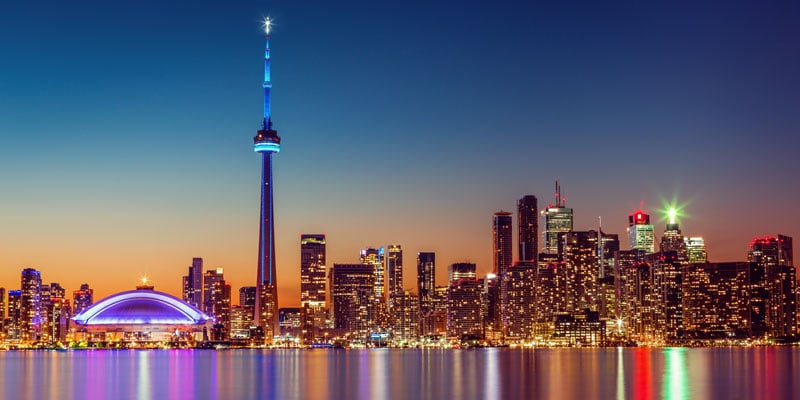
7/10 CN Tower, Toronto, Ontario
From its world famous film festival to the largest aquarium in Canada and the only ‘real’ castle in all of North America, Toronto’s larger than life in almost every way imaginable. But big could never be mistaken for brash. The city’s galleries, museums and historic districts are international icons. They even play ice-hockey with heritage here and don’t ever question the culture distilled in local craft brews.
So it takes a fairly striking feat of construction to stare down Toronto. And the CN Tower is all that. At almost 600 metres, it’s far from the tallest building on earth these days. But it is the only one where you can step out into thin air at 149 storeys high and skim round the circumference with nothing between you and the ground but a harness and nerves of steel. The world’s highest, hands-free experience, EdgeWalk is about as extreme as it gets – even in Canada.
The slightly more cautious can stroll over the 70mm thick glass floor at 113 storeys or watch daring EdgeWalkers from the enclosed upper storey SkyPod or just have a nice cup of tea and a 360˚ view of the city from the safety of the revolving restaurant.
Where: Toronto When: 364 days a year from 9am to 10.30pm
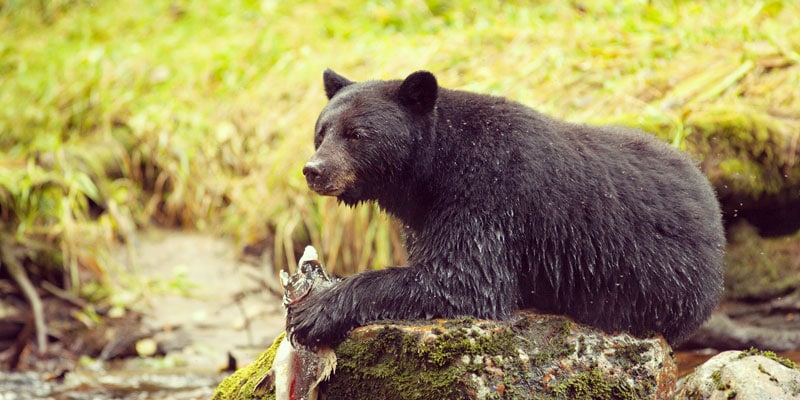
8/10 Great Bear Rainforest, Northern British Columbia
Between ocean and mountain, two million hectare Great Bear is the world’s largest and last remaining temperate rainforest. A miraculous environment where 1000 year old cedar trees still grow, ancient cultures flourish and the wildest of wildlife is a constant presence.
This is the natural habitat of the Spirit Bear: a black bear which, thanks to a recessive gene, has a pure white coat. Possibly the most mysterious of all Canada’s awe-inspiring creatures, it’s also known as the Kermode Bear and has long lived at the root of traditional myth, legend and ritual.
Wandering into any Canadian forest alone, in search of bears, isn’t a good plan. On the other hand, joining forces with expert Spirit Bear guides and staying in the heart of Rainforest is destined to be one of those never forgotten experiences people back home will eventually beg you to stop talking about.
Kitasoo/Xai’xais First Nations have lived here for thousands of years, visitors to the forest are their guests and learning about their customs and culture is another of the many reasons to shift Great Bear Rainforest up top on your Canadian wish list.
Where: Great Bear Rainforest, Northern British Columbia
When: June to October, tours from four to seven days
Who: Spirit Bear Lodge

9/10 Sea-to-Sky Gondola, Squamish, British Columbia
Less romantically known as Highway 99, the stretch of road which links Howe Sound (the sea) to Whistler Mountain (the sky) more than owns a place on the world’s most scenic routes’ list. It’s where water meets forest meets soaring peaks and has everything from enormous waterfalls to breathtaking bays and magnificent cirque in between.
All very thrilling and majestic but not quite as heart-in-the-mouth exciting as a 10 minute ride on the Sea-to-Sky Gondola from Howe Sound to the top of the mountain. At 885m above sea level it’s not for the faint of heart. But the beautifully designed cabins feel remarkably stable, only carry eight passengers at a time and provide sensational distractions in every direction.
Catch your breath at the top and then ready yourself for more derring-do on walking trails with cantilevered observation platforms, challenging rock climbing routes, backcountry paths and the must-do trek across incredible Sky Pilot Suspension Bridge.
Where: Highway 99, Sea-to-Sky Road, British Columbia When: all year round from 10am Who: Sea-to-Sky Gondola
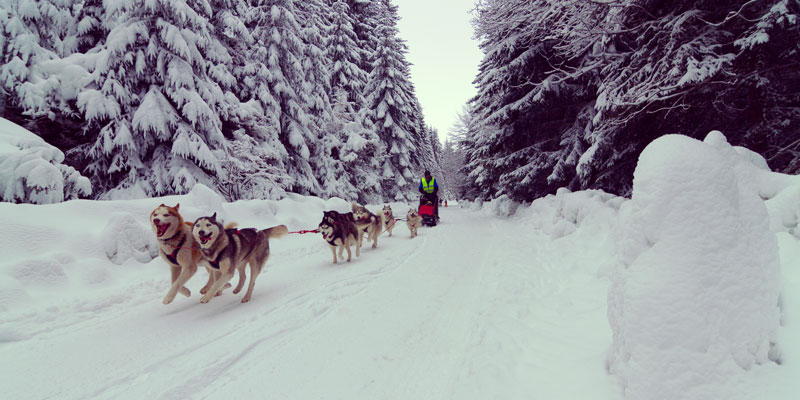
10/10 Dog Sledding, Northern Saskatchewan
Nothing says Canadian adventure quite like a team of sled dogs, elk stew and a canvas trapper’s tent. If that sounds like your type of holiday, head for the million acre Great Northern Forest in Saskatchewan.
Days here are spent getting to know your dogs, learning the ways of the sled and traversing the frozen wilderness landscapes where for centuries man and beast have pitted themselves as one against the elements.
Naturally, there’s a high level of comfort involved too or so many intrepid visitors wouldn’t return to do this year after year. But the activities are satisfyingly extreme and, once you get used to the freezing temperatures, extremely exciting.
Dog sledding proper might be a bit of an ask for younger kids, so Puppy Camps work well for under 10s to meet veteran sled dogs, romp around outside, learn new skills and – occasionally – actually see new born pups.
Where: Waskesiu, Saskatchwan
When: November to March
Who: Sundogs Sled Excursions

